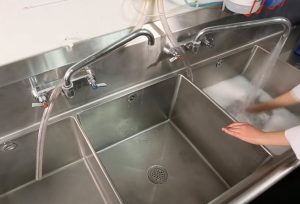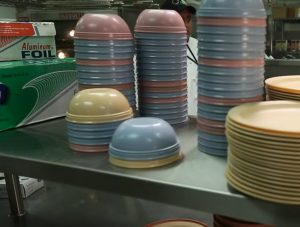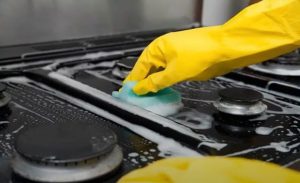If preparing food is your love language, then hygiene should be your main ingredient! We all know the kitchen is the heart of our home where all the cooking magic happens. Whether you are a home cook or a professional cook, maintaining good hygiene in your kitchen deserves substantial attention. Make sure everyone on board in the kitchen, from your friends to fellow chefs, follows sanitation rules in the kitchen to keep nasty germs and bacteria at bay.
Follow these essential sanitation rules in the kitchen to keep the atmosphere clean and free of harmful germs.
Rules for the Professional Restaurant
Running a food business in a professional restaurant is laden with innumerable challenges.  As a prospering chef with a thriving business, you need to maintain your staff, promote your business and cater to your customer’s requirements by ensuring that they are satisfied. In addition to this, you also need to make sure that you are looking after the restaurant’s sanitation activities well. If you maintain your restaurant’s sanitation, you will create an immersive experience for your customers. Your customers will love enjoying their meals in a safe and clean atmosphere. It will open doors to a loyal customer following who might even become your fans.
As a prospering chef with a thriving business, you need to maintain your staff, promote your business and cater to your customer’s requirements by ensuring that they are satisfied. In addition to this, you also need to make sure that you are looking after the restaurant’s sanitation activities well. If you maintain your restaurant’s sanitation, you will create an immersive experience for your customers. Your customers will love enjoying their meals in a safe and clean atmosphere. It will open doors to a loyal customer following who might even become your fans.
However, it would be easier if you don’t make following sanitation rules feel like a challenge for yourself or your staff. Take it easy and urge your teammates on board to do the same.
Here are our vital and innovative sanitation practices that could help you create a clean and healthy kitchen atmosphere at your restaurant. Have a closer look:
Sanitation Rules in the Kitchen
Safe environment:
The most important rule that needs to be stated is ensuring that the atmosphere of your kitchen and dining area safe. If you genuinely show that you are making efforts to ensure that your customers are dining in a safe space, they might enjoy their meals even more and return to your restaurant with satisfaction.
You can cultivate a safe environment in your kitchen and dining areas by ensuring regular cleaning with detergents and water. It effectively helps to combat the spread of germs and viruses.
Another way to ensure a safe environment is by installing hand-washing stations and hand-sanitizer stations at various spots in your kitchen area. You can even install them near your dining areas. In this way, you can encourage visitors and staff members to consistently wash and sanitize their hands before and after preparing meals.
Cleaning schedule:
You can maintain higher cleanliness standards in your restaurant by preparing a cleaning schedule. It gets easier to stay organized and manage your cleaning practices with a schedule in your hand.
Make weekly and daily goals for your cleaning routine. Make sure your staff regularly cleans and sanitizes kitchen surfaces that come directly in contact with the food. It is also essential to assure that kitchenware and dining table utensils are washed and sterilized on a daily basis. It is essentially that you clean the dishwashing area and clear all the grease off on an everyday basis. In contrast, you can focus on other tasks like sterilizing stoves, ovens and fryers every week.
Another part of your cleaning routine should include laundering cloth that you use to wipe kitchen counter tops and handle other tasks.
If you think your professional chefs are not eligible to maintain a cleaning schedule, hire a disinfectant service or a special cleaning service. These services will ensure proper and daily cleaning of your restaurant and kitchen area. Your chefs can pay considerable attention to cooking and their personal hygiene while the hired service takes care of the rest.
Staff hygiene:
Another crucial factor in restaurants is to focus on maintaining staff hygiene. Your in-house chefs should implement all the food and safety guidelines while working in the kitchen.
Make sure that they wear disposable rubber gloves while working in the kitchen. If they are dealing with raw meat, they quickly change their gloves before touching anything else. Besides this, you could even ensure a constant supply of antibacterial gloves to your staff members that mitigates any changes of bacteria transfers into the food.
It is also crucial to see if your chefs wear clean aprons all the time. It would be great if you can ask them to wear a dedicated uniform while working in the kitchen area as well.
Follow food and safety procedures:
Urge all your chefs to follow food and safety procedures and guidelines while working in the kitchen space at your restaurant. These practices are beneficial for your staff as well as customers. It also prevents the spread of any illnesses and viruses.
 While cooking, keep cutting boards, knives, and other equipment and surfaces clean. To reduce the risk of cross-contamination, have special cutting boards and utensil sets available for raw meat. These should be clearly marked and stored apart from produce preparation gear. Using running water and occasionally a clean produce brush, your cooks should wash and clean vegetables. However, avoid washing meats because the water could contaminate other parts of the kitchen. Having a variety of thermometers accessible for use—which you should clean frequently—will help you ensure that the culinary crew adheres to the recommended food temperature ranges.
While cooking, keep cutting boards, knives, and other equipment and surfaces clean. To reduce the risk of cross-contamination, have special cutting boards and utensil sets available for raw meat. These should be clearly marked and stored apart from produce preparation gear. Using running water and occasionally a clean produce brush, your cooks should wash and clean vegetables. However, avoid washing meats because the water could contaminate other parts of the kitchen. Having a variety of thermometers accessible for use—which you should clean frequently—will help you ensure that the culinary crew adheres to the recommended food temperature ranges.
Make sure all your chefs are aware about the recommended temperature ranges in the kitchen by hanging them in the kitchen so that personnel can easily refer to them when preparing food.
Layout issues:
It would be best if you reconsider the layout of your kitchen and resolve any issues with

the design and functionality of your kitchen. Oftentimes, it is the faulty and messy layout of the kitchen that leads to chaos and spillage. If possible, redesign!
While reconsidering your kitchen design, ensure that you take care of some factors which include, ample distance between chefs, proper airflow, and ventilation. These factors facilitate the cooking process and boost cleanliness. It gets easier to reach every corner and boost the cleanliness of every nook and cranny of your kitchen.
Minimize personal contact:
A key to maintaining cleanliness in your restaurant’s kitchen is to minimize personal contact during cooking or interacting with the customers. Browse for innovative solutions that prevent personal contact and boost your workflow.
An excellent technological solution for minimizing personal contact is by going digital. Offer digital menu cards and receive customer feedback on a tablet or iPad. The switch to digital will help your staff to limit interaction with clients.
You might offer other choices like curbside pick-up stations and home delivery as a part of your takeaway services. It will be unnecessary for customers to interact with staff if a pick-up station is set up next to your restaurant where they may pick up their orders and go. Additionally, by allowing customers to prepay for their delivery orders online or through a mobile app, deliveries can be left at the door rather than picked up by a staff member from the restaurant. This saves valuable staff time so they may concentrate on maintaining the cleanliness of your restaurant.
Sanitation Rules in the Kitchen for the Home-Chef
Rules for home chefs might differ from the professional chefs on various grounds. However, it needs as much attention as any professional kitchen. While cooking for friends, family or kids, you need to ensure whatever they consume is freshly prepared in a safe and clean environment.
Make following sanitation rules in your home kitchen fun and easy. Ask all your family members to get involved in the whole process. Pro-tip for mothers would be to ask their kids to make a creative chart for these rules and stick it in the kitchen.
Keep your loved ones healthy and happy by following these essential sanitation rules in your home kitchen. Take a look at our home kitchen sanitation 101:
Personal hygiene:
Personal hygiene comes at the top of the kitchen sanitation 101. You cannot begin your cleaning mission without ensuring your personal hygiene.
The most important kitchen hygiene tip is to always have clean hands. As you prepare and cook food, wash your hands frequently to prevent the spread of bacteria. Make sure that everyone in the family and kids understands how to wash their hands properly as frequent hand washing is one of the most basic kitchen hygiene standards.
While you are occupied in the kitchen, make sure you take off your jewelry items, especially rings as they make it difficult to properly clean your hands. Besides this, germs might reside in your rings or other jewelry items and you might not even know.
Another pro-tip while cooking is to keep your nails short and remove nail paint. It is also essential to tie your hair or wear a hat or hair net while cooking. Your hair also carries a lot of germs that might contaminate your food.
Basics of the bin:
A crucial component of kitchen hygiene is routine trash replacement. Take your trash out every day to avoid any strange odors because old food in a bin will quickly decay and bacteria will begin to multiply.
Avoid cross contamination:
You’ll realize why eliminating cross-contamination is a key component of kitchen hygiene guidelines if you’ve ever had food illness. You don’t want dangerous bacteria to transfer from raw food to cooked food and infect you. It is vital to use different cookware for raw food and cooked food. Always use distinct color cutting boards for fish, meat, vegetables, dairy, and bread. It might help if you use various colors for each board.
Food storage:
You should always look out for appropriate food storage practices. A proper storage ensures that there is minimum air contact with food which keeps food safe from potentially dangerous chemicals and germs. It is essential to pack all the opened packages and food leftovers before you stuff them in the fridge or discard them. Do not leave your food in the air for more than two hours. Additionally, you must use airtight containers for foods like wheat, rice, and pasta that are kept on shelves or in cabinets.
Ensure that you place packaged food on plates to prevent juices from spilling down the countertops or refrigerator shelves. Items that have expired should not be kept in your refrigerator. Don’t overcrowd your refrigerator since it impacts the air circulation and your food can go stale. It is important to remember not to place heated food in the refrigerator. It must first cool, but should be placed in the freezer or the refrigerator as immediately as possible, preferably within two hours. When preparing family meals to freeze, keep this in mind!
Regularly wash your dishes:
If you don’t want to create a hassle for yourself for the next day and invite germs on the unwashed dishes, it would be best to wash them regularly. Experts say that bacterias can only survive on the surface, hence it is crucial to wash and clean all your kitchenware once you are done with your meal.
Clean your sink and counter tops:
 One of the simplest yet the most fundamental kitchen hygiene guidelines is to wipe down kitchen counters after every use. Along with maintaining order and cleanliness, you’ll also be preventing the spread of bacteria.
One of the simplest yet the most fundamental kitchen hygiene guidelines is to wipe down kitchen counters after every use. Along with maintaining order and cleanliness, you’ll also be preventing the spread of bacteria.
Your sink is used frequently throughout the day; therefore, if it is not kept clean, it will rapidly become dirty and coated in bacteria. Once every day, quickly scrub your sink with a scrubbing brush and a splash of kitchen cleaner. Following this guideline of kitchen hygiene won’t take much time, but it’s always worth it.
Final Thoughts on Sanitation Rules for the Kitchen
At a glance, if you want to wow your customers with an impressive clean and safe service at your restaurants, our sanitation practices will be extremely handy. On the other hand, our sanitation practices for home kitchens can also keep you and your loved ones healthy and safe from harmful bacteria and air-borne germs hiding in your kitchen that might infect your food. We hope that our guide gives you an insight into cleaning practices to follow in your kitchen. You would love to work in an organized and pristine kitchen environment!
